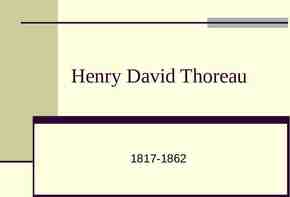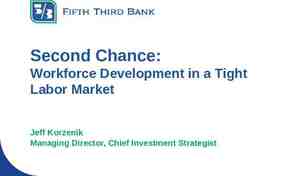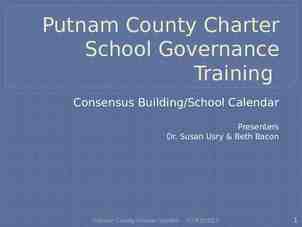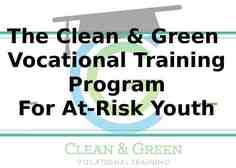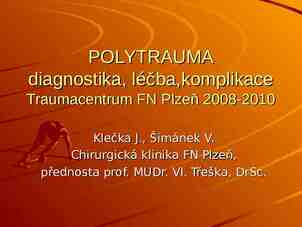Exploiting Semantics of Web Services in eBusiness Asuman Dogac
92 Slides1.14 MB

Exploiting Semantics of Web Services in eBusiness Asuman Dogac Applications Middle East Technical University 06531 Ankara Turkey Asuman Dogac RIDE 2004, Boston, March 28, 200 4 1/92

Outline Why do we need the semantics of Web services? Means of expressing semantics: Ontology and Ontology Description Languages Semantic Support Available in UDDI Registries Semantic Support Available in ebXML Registries Two approaches to exploiting semantics: Querying and Reasoning Describing the semantics of Web services in two domains Healthcare Tourism Industry Asuman Dogac RIDE 2004, Boston, March 28, 200 4 2/92

Why do we need the semantics of Web services? Asuman Dogac RIDE 2004, Boston, March 28, 200 4 3/92

Why do we need Web Service Semantics? WSDL only gives the technical specification of the Web services In order to exploit services in their full potential their properties must be defined: The methods of charging and payment The channels by which the service is requested and provided Constraints on temporal and spatial aspects Availability Service quality Security, trust and rights attached to a service Asuman Dogac RIDE 2004, Boston, March 28, 200 4 4/92

Why do we need Web Service Semantics? To be able to define the Web service functionality semantics To be able to describe service properties and later search for services according to their properties This search needs to be done in a machine processable and interoperable manner Asuman Dogac RIDE 2004, Boston, March 28, 200 4 Defining Service Properties Through Ontology Languages 5/92

Ontology Asuman Dogac RIDE 2004, Boston, March 28, 200 4 6/92

What is an Ontology? “An explicit formal specification of the terms in the domain and relations among them.” - Noy and McGuinness, “Ontology Development 101” The word ontology comes from the Greek ontos (being) and logos (word) Class An ontology describes objects and concepts as classes Subclass These classes are arranged in a hierarchy, and then class attributes and relationships are described with properties Subclass Asuman Dogac RIDE 2004, Boston, March 28, 200 4 properties properties 7/92

Why use an ontology? A common vocabulary Ability to define relationships among classes, properties and instances Automated Processing 1. Querying 2. Reasoning Asuman Dogac RIDE 2004, Boston, March 28, 200 4 8/92

Resource Description Framework (RDF) A W3C recommendation RDF fixes the syntax and structure of describing metadata through RDF Syntax It allows meaning to be defined and associated with data through RDF Schema RDF Schema facilities to define domain specific ontologies Asuman Dogac RIDE 2004, Boston, March 28, 200 4 9/92

Ontology Languages and OWL OIL: Ontology Inference Layer (European Commission Project) DAML:Darpa Agent Markup Language DAML OIL RDF (Resource Description Framework) OWL: Web Ontology Language (Being Standardized by W3C) Asuman Dogac RIDE 2004, Boston, March 28, 200 4 10/92

OWL Classes owl:Class rdf:ID “Crimes" /owl:Class Ministry of Interior has defined ontologies for their information in OWL For example: Crimes Robbery owl:Class rdf:ID “Robbery" rdfs:subClassOf rdf:resource "#Crimes"/ /owl:Class Asuman Dogac Speeding Terrorism owl:Class rdf:ID “Terrorism" rdfs:subClassOf rdf:resource "#Crimes"/ /owl:Class RIDE 2004, Boston, March 28, 200 4 11/92

OWL Properties owl:DatatypeProperty rdf:ID “description" rdfs:domain rdf:resource "#Crime"/ rdfs:range rdf:resource “http://www.w3.org/2001/XMLSchem description Crimes Literal a#Literal"/ /owl:DatatypeProperty owl:ObjectProperty rdf:ID “suspect" rdfs:domain rdf:resource "#Robbery"/ rdfs:range rdf:resource “#Thief /owl:ObjectProperty owl:ObjectProperty rdf:ID “driver" rdfs:domain rdf:resource "#Speeding"/ rdfs:range rdf:resource “#Speeder"/ /owl:ObjectProperty Asuman Dogac suspect Robbery Speeding RIDE 2004, Boston, March 28, 200 4 Thief driver Speeder 12/92

An Example: eGovernment Finger prints from a robbery scene identified John Smith as the suspect Here is the police report on the robbery: Robbery rdf:ID "report-2003-10-23-xyz" description . /description suspect Thief rdf:about "http://www.ministryOfInterior.gov/criminals#John Smith"/ /suspect /Robbery Asuman Dogac RIDE 2004, Boston, March 28, 200 4 13/92

An Example: eGovernment Later in the day a police gives a person a ticket for speeding The driver's license showed the name John Doe Here is the police report on the speeder: Speeding rdf:ID "report-2003-10-23-abc" description . /description driver Speeder rdf:about "http://www.ministryOfInterior/criminals#John Doe"/ /driver /Speeding Asuman Dogac RIDE 2004, Boston, March 28, 200 4 14/92

Any Relationship between the Thief and the Speeder? Ministry of Interior keeps the OWL descriptions of their files: Criminals rdf:about " http://www.ministryOfInterior/criminals#John Doe " owl:sameAs rdf:resource " http://www.ministryOfInterior.gov/criminals#John Smith "/ /Criminals Asuman Dogac RIDE 2004, Boston, March 28, 200 4 15/92

How can this be achieved? owl:sameAs property helps! Thief John Smith owl:sameAs Speeder John Doe Inference: The Thief and the Speeder are one and the same! OWL provides a property (owl:sameAs) for indicating that two resources (e.g., two people) are the same Asuman Dogac RIDE 2004, Boston, March 28, 200 4 16/92

Semantic Support of Web Services in UDDI Registries Asuman Dogac RIDE 2004, Boston, March 28, 200 4 17/92

UDDI Registry APIs Inquiry API Find find business find service find binding find tModel get businessDetail get serviceDetail get bindingDetail get tModelDetail Asuman Dogac Save Get Details Publishers API save business save service save binding save tModel Delete delete business delete service delete binding delete tModel RIDE 2004, Boston, March 28, 200 4 18/92

Defining Service Semantics in UDDI Registries businessEntity By using standard taxonomies And by putting the corresponding tModel keys in the category bags of services Asuman Dogac businessKey name URL description contacts businessServices identifierBag categoryBag keyedReference keyedReference tModelKey tModelKey keyName keyName keyValue keyValue RIDE 2004, Boston, March 28, 200 4 Contact Contact Phone Phone Address Address Email Email businessService businessService serviceKey Key tModelKey Name Name Description Description BindingTemplates BindingTemplates keyedReference keyedReference tModelKey tModelKey keyName keyName keyValue keyValue 19/92

Business categories in UDDI Three standard taxonomies in V1 Industry: NAICS - North American Industrial Classification Scheme (Industry codes - US Govt.) Product/Services: UN/SPSC - Universal Standard Products and Services Classification (ECMA) Location: ISO 3166 Geographical taxonomy Asuman Dogac RIDE 2004, Boston, March 28, 200 4 20/92

ISO 3166 Codes (Countries) (http://www.iso.ch/iso/en/prods-services/iso31 66ma/) Country A2 A3 Number ITALY IT ITA 380 TURKEY TR TUR 792 Asuman Dogac RIDE 2004, Boston, March 28, 200 4 21/92

North American Industry Classification System (NAICS) Asuman Dogac RIDE 2004, Boston, March 28, 200 4 22/92

United Nations Standard Products & Services Code (UNSPSC) Asuman Dogac RIDE 2004, Boston, March 28, 200 4 23/92

How can we find a service through its semantics in UDDI Registries? Looking for a service to buy a Computer If a service puts the tModel key corresponding to [43.17.18.03] Workstations or desktop computers – commodity in its category bag THEN We know that this service is related with computers BUT: Is this service really selling computers? If so how about the properties of the product? Payment method? Memory, Speed? Asuman Dogac RIDE 2004, Boston, March 28, 200 4 24/92

Taxonomies Define Only Class/Subclass Relationship: An UDDI uses Example Taxonomy: UNSPSC taxonomies to describe 43.00.00.00.00 Communications and Computer Equipment and Peripherals and Components and Supplies the semantic of Web services by relating them to tModels Through taxonomies: It is not possible to define properties of services 43.16.17.00.00 Business Transaction and Personal Business Software It is not possible to relate service classes with one another 43.16.17.02.00 Tax Preparation Software Asuman Dogac RIDE 2004, Boston, March 28, 200 4 25/92

Semantic Support of Web Services in ebXML Registries Asuman Dogac RIDE 2004, Boston, March 28, 200 4 26/92

Where to store the generic semantics of the services? An ebXML registry allows to define semantics basically through two mechanisms: It allows properties of registry objects to be defined through “slots” and, Metadata can be stored in the registry through a “classification” mechanism Asuman Dogac RIDE 2004, Boston, March 28, 200 4 27/92

ebXML Registry Information Model (RIM) RegistryObject ClassificationNode ClassificationScheme Asuman Dogac Classification RegistryEntry RegistryPackage Association ExtrinsicObject RIDE 2004, Boston, March 28, 200 4 Service 28/92

Exploiting semantics TravelService Transportation Accommodation Entertainment Service Service Service AirTransportation In relating the semantics ReserveAFlight BuyATicket with the services advertised in service registries, there originatingFrom destinationTo paymentMethod are two key issues: Where to store the generic semantics of the ReserveAFlight services: In ebXML, metadata is stored in the registry originatingFrom destinationTo paymentMethod How to relate the services advertised in the registry with the semantic defined through an ontology: In MyService ebXML through Classification objects ? ? Asuman Dogac RIDE 2004, Boston, March 28, 200 4 29/92

Relating a Web service Advertised with Service Ontology in ebXML ServiceToIndustryClassification: Classification classsifiedObject MyService: Registry Entry Asuman Dogac classificationNod e ReserveAFlight: ClassificationNode RIDE 2004, Boston, March 28, 200 4 30/92

How to relate services advertised with the generic By relating a service advertised with a node in classification ontology classes? hierarchy, we make the service an explicit member of this node The service also inherits the well-defined meaning associated with this node as well as the generic properties defined for this node When we associate “MyService” with “ReserveAFlightService”, its meaning becomes clear; that this service is a flight reservation service Assuming that the “ReserveAFlightService” service has the generic properties such as “originatingFrom”, “destinationTo” and “paymentMethod”, “MyService” also inherits these properties Asuman Dogac RIDE 2004, Boston, March 28, 200 4 31/92

Querying vs. Reasoning Asuman Dogac RIDE 2004, Boston, March 28, 200 4 32/92

Some Observations Ontologies can play two major roles in the Web services area: One is to provide a source of shared and precisely defined terms which can be used to dynamically discover, compose and monitor services The other is to reason about the ontologies Asuman Dogac RIDE 2004, Boston, March 28, 200 4 33/92

Some Observations The fact is that we do not have industrial strength reasoners yet! Semantic can also be taken advantage of through querying Asuman Dogac RIDE 2004, Boston, March 28, 200 4 34/92

Exploiting Semantics through Querying Once semantics is associated with Web services in ebXML registries, it can be used to discover services simply through queries Examples: It is possible to find the properties of a Web service class It is possible to find all the advertised instances of a Web service class in the ontology It is possible to obtain the content files (WSDL and OWL) Asuman Dogac RIDE 2004, Boston, March 28, 200 4 35/92

Querying ebXML Registry through Query Templates This can be achieved through predefined query templates which yields into automation: A query template is used to obtain the properties of a generic class A query template is used for locating service instances of a given generic class node in the class hierarchy A template is a content retrieval query to obtain the original OWL and WSDL files through the identifiers of the OWL and WSDL files in the SpecificationLinks Asuman Dogac RIDE 2004, Boston, March 28, 200 4 36/92

A query template to obtain the properties of a generic class ebXML Registry TravelService DatatypeProperty Transportation Accommodation Entertainment Service Service Service AirTransportation ReserveAFlight originatingFrom destinationTo ebXML Query Get Datatype Properties ebXML Query Result ObjectProperty BuyATicket paymentMethod 1 1 2 2 ebXML Query Get Object Properties ebXML Query Result paymentMethod originatingFrom destinationTo Asuman Dogac promotion promotion RIDE 2004, Boston, March 28, 200 4 37/92

An Example Query Retrieving all the Associations of Type “DatatypeProperty” for “ReserveAClassFlightService” AdhocQueryRequest xmlns "urn:oasis:names:tc:ebxml-regrep:query:xsd:2.0" xmlns:xsi "http://www.w3.org/2001/XMLSchema-instance" xsi:schemaLocation "urn:oasis:names:tc:ebxml-regrep:query:xsd:2.0 query.xsd" ResponseOption returnType "LeafClass" returnComposedObjects "true" / FilterQuery ClassificationNodeQuery SourceAssociationBranch AssociationFilter Clause SimpleClause leftArgument "associationType" StringClause stringPredicate "Equal" DatatypeProperty /StringClause /SimpleClause /Clause /AssociationFilter ClassificationNodeQuery NameBranch LocalizedStringFilter Clause SimpleClause leftArgument "value" StringClause stringPredicate "Contains" ReserveAFlightService /StringClause /SimpleClause /Clause /LocalizedStringFilter /NameBranch /ClassificationNodeQuery /SourceAssociationBranch /ClassificationNodeQuery /FilterQuery /AdhocQueryRequest Asuman Dogac RIDE 2004, Boston, March 28, 200 4 38/92

A query template to find all the advertised instances of a Web service class ebXML Registry TravelService Accommodation Entertainment Service Service Transportation Service AirTransportation ReserveAFlight MyService1 BuyATicket MyService2 1 2 MyService3 ebXML Query Get Extension of a ClassificationNode ebXML Query Result MyService1 MyService2 Asuman Dogac RIDE 2004, Boston, March 28, 200 4 MyService3 39/92

An Example Query: Retrieving all the Services Classified with “ReserveAFlightService” ClassificationNode AdhocQueryRequest xmlns "urn:oasis:names:tc:ebxml-regrep:query:xsd:2.0" xmlns:xsi "http://www.w3.org/2001/XMLSchema-instance" xsi:schemaLocation "urn:oasis:names:tc:ebxml-regrep:query:xsd: 2.0 query.xsd" ResponseOption returnType "LeafClass" returnComposedObjects "true" / FilterQuery ServiceQuery ClassifiedByBranch ClassificationNodeQuery NameBranch LocalizedStringFilter Clause SimpleClause leftArgument "value" StringClause stringPredicate "Equal" ReserveAFlightService /StringClause /SimpleClause /Clause /LocalizedStringFilter /NameBranch /ClassificationNodeQuery /ClassifiedByBranch /ServiceQuery /FilterQuery /AdhocQueryRequest Asuman Dogac RIDE 2004, Boston, March 28, 200 4 40/92

ebXML Registry ebXML Repository TravelService Transportation Service Accommodation Service Entertainment Service AirTransportation ReserveAFlight SpecificationLink MyService1 2 Extrinsic Object ebXML Query Get SpecificationLink Content of a Service A Content Retrieval Query template ebXML Query Result WSDL of MyService1 Asuman Dogac OWL-S of MyService1 Extrinsic Object BuyATicket 1 WSDL of MyService1 OWL-S of MyService1 RIDE 2004, Boston, March 28, 200 4 41/92

Retrieving the WSDL Files GetContentRequest xmlns "urn:oasis:names:tc:ebxml-regrep:query:xsd:2.1" xmlns:rim "urn:oasis:names:tc:ebxml-regrep:rim:xsd:2.1" xmlns:xsi "http://www.w3.org/2001/XMLSchema-instance" xsi:schemaLocation "urn:oasis:names:tc:ebxml-regrep:rim:xsd:2.1 ./schema/rim.xsd urn:oasis:names:tc:ebxml-regrep:query:xsd:2.1 ./schema/query.xsd" rim:ObjectRefList --! The unique id of the WSDL file in the registry -- rim:ObjectRef id "urn:uuid:7e4397db-916a-490f-bdc7-c9da"/ /rim:ObjectRefList /GetContentRequest Asuman Dogac RIDE 2004, Boston, March 28, 200 4 42/92

OWL-S Asuman Dogac RIDE 2004, Boston, March 28, 200 4 43/92

OWL-S: Defines an Upper Ontology for Web Services in OWL Resource ServiceProfile presents: What it does provides Service ServiceGrounding Asuman Dogac Supports: How to access it describedBy:How it works ServiceModel RIDE 2004, Boston, March 28, 200 4 44/92

Web services and the Healthcare Domain Asuman Dogac RIDE 2004, Boston, March 28, 200 4 45/92

Challenges of Healthcare Informatics According to Jonathan Borden, M.D. of ASTM: A disaster: 1.1 Trillion /year in the USA 30-40 % overhead Mostly paper based Highly proprietary commercial systems Tens of thousands of people die each year due to poor information/errors Most of the information is rendered useless Asuman Dogac RIDE 2004, Boston, March 28, 200 4 46/92

Asuman Dogac RIDE 2004, Boston, March 28, 200 4 47/92

Challenges of Healthcare Informatics Most of the health information systems today are proprietary They often only serve one specific department within a healthcare institute To complicate the matters worse, a patient's health information may be spread out over a number of different institutes which do not interoperate This makes it very difficult for clinicians to capture a complete clinical history of a patient Asuman Dogac RIDE 2004, Boston, March 28, 200 4 48/92

Patient Records: Problems Content: too little, too much, or wrong Format: poor organization of information Access, availability, security Linkages and integration Asuman Dogac RIDE 2004, Boston, March 28, 200 4 49/92

Challenges of Healthcare Informatics The systems must interoperate for effectiveness For interoperability standards are needed However there are more than one standard in the health care domain Asuman Dogac RIDE 2004, Boston, March 28, 200 4 50/92

EHR Architectures The nice thing about standards is that there are so many to choose from. Andrew Tanenbaum, Introduction to Computer Networks „Candidates“ of EHR architectures: CEN ENV 13606 „EHR Communication“ Good Electronic Health Record (GEHR) OpenEHR CEN EN 13606 (draft) HL7 Clinical Document Architecture HL7 v2 Information Model (implicit) HL7 v3 Reference Information Model (draft) Asuman Dogac RIDE 2004, Boston, March 28, 200 4 51/92

Web Services in the Healthcare Domain Web services provides the healthcare industry with an ideal platform to achieve the difficult interoperability problems Web services are designed to wrap and expose existing resources and provide interoperability among diverse applications It becomes possible to provide the interoperability of medical information systems through standardizing the access to data through WSDL and SOAP rather than standardizing documentation of electronic health records Asuman Dogac RIDE 2004, Boston, March 28, 200 4 52/92

Introducing Web services to the healthcare domain brings many advantages Medical information systems suffer from proliferation of standards to represent the same data; Web services allow for seamless integration of disparate applications representing different and, at times, competing standards Web services will extend the healthcare enterprises by making their own services available to others Web services will extend the life of the existing software by exposing previously proprietary functions as Web services Asuman Dogac RIDE 2004, Boston, March 28, 200 4 53/92

Semantics of Web Services In order to exploit Web services to their full potential, it is necessary to describe their semantics An essential element in defining the semantic of Web services is the domain knowledge Medicine is one of the few domains to have extensive domain knowledge defined through standards Asuman Dogac RIDE 2004, Boston, March 28, 200 4 54/92

Domain Knowledge Some of the domain knowledge exists in controlled vocabularies, or terminologies: Some vocabularies are rich semantic nets, such as SNOMED-CT while others such as ICD-10 (International Statistical Classification of Diseases and Related Health Problems) is little more than lexicons of terms However, there are also standards that expose the business logic in the healthcare domain such as HL7 and Electronic Healthcare Record based standards such as CEN TC251, ISO TC215 and GEHR which define and classify clinical concepts These standards offer significant value in developing ontologies to express the semantics of Web services Asuman Dogac RIDE 2004, Boston, March 28, 200 4 55/92

What kind of Semantics? Service Functionality Semantics: HL7 has categorized the events in healthcare domain by considering service functionality which reflects the business logic in this domain This classification can be used as a basis for defining the service action semantics through a Service Functionality Ontology Service Message Semantics: Electronic healthcare record (EHR) based standards like HL7 CDA (Clinical Document Architecture), GOM (GEHR Object Model), and CEN TC251's ENV 13606 define meaningful components of EHR so that when transferred, the receiving party can understand the record content better The meaningful components defined by these standards can be used in developing service message ontologies Asuman Dogac RIDE 2004, Boston, March 28, 200 4 56/92

HL7 and Web Services The primary goal of HL7 is to provide standards for the exchange of data among healthcare computer applications An event in the healthcare world, called the trigger event, causes exchange of messages between a pair of applications When an event occurs in an HL7 compliant system, an HL7 message is prepared by collecting the necessary data from the underlying systems and it is passed to the requestor, usually as an EDI message Mapping HL7’s message based events directly into Web services may result in several inefficiencies Asuman Dogac RIDE 2004, Boston, March 28, 200 4 57/92

HL7 and Web Services The input and output messages defined for HL7 events are usually very complex containing innumerous segments of different types and optionality Furthermore, all the semantics about the business logic and the document structure are hard coded in the message This implies that, the party invoking the Web service must be HL7 compliant to make any sense of the content of the output parameter(s) returned by the service Furthermore, the information contained in an HL7 message may be coming from different systems either proprietary or complying to different standards Hence, in Web services terminology, HL7 events correspond to Composite services, whereas more elementary services are needed Asuman Dogac RIDE 2004, Boston, March 28, 200 4 58/92

HL7 and Web Services Since HL7 has already been through an effort of categorizing the events in healthcare domain considering service functionality, it can be used as a basis for a service functionality ontology Asuman Dogac RIDE 2004, Boston, March 28, 200 4 59/92

An Example Service Functionality Ontology HealthCareServices PatientAdministration PatientCare PatientReferralRequest PatientReferral Scheduling PatientInfoRequest InsuranceInformation ClinicalInformation ObservationReporting CancelPatientReferral DemographicData GetClinicalInformation serviceQuality Asuman Dogac location RIDE 2004, Boston, March 28, 200 4 Properties of the Generic Service Class 60/92

Service Messages A Web service in the healthcare domain usually accesses or updates a part of an electronic healthcare record, that is, parts of the EHR constitute the service parameters An electronic healthcare record may get very complex with data coming from diverse systems such as lab tests, diagnosis, prescription of drugs which may be in different formats Electronic healthcare record (EHR) based standards like HL7 CDA, GOM and CEN's ENV 13606 aim to facilitate the interoperability between Medical Information Systems These standards provide conceptual building blocks or meaningful components We propose to use these standards as a basis for Service Message Ontology Asuman Dogac RIDE 2004, Boston, March 28, 200 4 61/92

GEHR EHR and Transaction level Navigation level Content (e.g. observation, subjective, instruction) level Data types (e.g. quantity, multimedia) level Clinical models are expressed outside the GOM in the form of archetypes Asuman Dogac RIDE 2004, Boston, March 28, 200 4 62/92

CEN TC 251 ENV 13606 Folder: High-level subdivisions of the entire EHR for a patient Composition: A set of record entries relating to one time and place of care delivery; grouped contributions to an aspect of health care activity; composed reports and overviews of clinical progress Headed Section: Sub-divisions used to group entries with a common theme or derived through a common healthcare process. Cluster: Low-level aggregations of elementary entries (Record Items) to represent a compound clinical concept Asuman Dogac RIDE 2004, Boston, March 28, 200 4 63/92

An example Service Message Ontology Concept Property Asuman Dogac RIDE 2004, Boston, March 28, 200 4 64/92

Relating the services with the semantic defined through an ontology UDDI UDDI Business Entities and Related HacettepeHospital UDDI tModels ObservationReportingServices Medical Services . . . PatientCare PatientReferral PatientReferralServices GetClinicalInfo getClinicalInfo Observation Reporting PatientReferralReq CategoryBag reference Asuman Dogac RIDE 2004, Boston, March 28, 200 4 65/92

Associating semantics to ebXML HealthCareServices subclassOf subclassOf PatientCare PatientAdministration ObservationReporting subclassOf PatientReferralRequest subclassOf PatientInfoRequest Standards Conformed serviceQuality ebXML Classification Hierarchy ebXML ClassificationNodes Asuman Dogac ebXML associations ebXMLslots RIDE 2004, Boston, March 28, 200 4 66/92

The healthcare informatics industry has already started using Web services An Example: Integrating the Healthcare Enterprise (IHE) IHE defines a Web service based implementation framework Asuman Dogac RIDE 2004, Boston, March 28, 200 4 67/92

Overview of IHE IT Infrastructure Integration Profiles IHE IT Infrastructure Technical Committee Charles Parisot, GE Medical Systems Information Technologies Asuman Dogac RIDE 2004, Boston, March 28, 200 4 68/92

IHE IT Infrastructure 5 Integration Profiles Retrieve Information for Display Access a patient’s clinical information and documents in a format ready to be presented to the requesting user Patient Synchronized Applications Synchronize multiple applications on a desktop to the same patient Patient Identifier Cross-referencing for MPI Consistent Time Map patient identifiers across independent identification domains Coordinate time across networked systems Asuman Dogac Enterprise User Authentication RIDE 2004, Boston, March 28, 200 4 Provide users a single name and centralized authentication process across all systems 69/92

An Example: Retrieve Information for Display Key Technical Properties: Standards Used: Web Services (WSDL for HTTP Get). General purpose IT Presentation Formats: XHTML, PDF, JPEG plus CDA L1. Client may be off-the-shelf browser or display app. Two services : Retrieve of Specific Information: Patient centric: patient ID Type of Request Date, Time, nMostRecent Retrieve a Document Asuman Dogac Object Unique Instance Identifier (OID) Type of Request Content Type Expected RIDE 2004, Boston, March 28, 200 4 70/92

Retrieve Information for Display Transaction Diagram Display Retrieve Specific Info for Display [11] Information Source Retrieve Document for Display [12] Types of Requests Summary of All Reports Summary of Laboratory Reports Summary of Radiology Reports Summary of Cardiology Reports Summary of Surgery Reports Summary of Intensive Care Reports Summary of Emergency Reports Summary of Discharge Reports List of Allergies List of Medications Persistent Document Asuman Dogac RIDE 2004, Boston, March 28, 200 4 71/92

For Further Information IST-1-002103-STP Artemis Project: A Semantic Web Service-based P2P Infrastructure for the Interoperability of Medical Information Systems http://www.srdc.metu.edu.tr/artemis/ Asuman Dogac RIDE 2004, Boston, March 28, 200 4 72/92

Web Services and the Travel Industry Asuman Dogac RIDE 2004, Boston, March 28, 200 4 73/92

Overall Information Flow in Tourism Domain About 1000 companies About 100,000 Hotels Hotels Hilton Ankara, Sofitel Paris . 4 major GDSs Hundreds Airline Companies 10 small Olympic, Air France Of Chains XML Two companies Hotel Switching Chains Companies Hilton, BW, GDS Cryptic Pegasus, Utell, E-Rez, Tens of Thousands Of agencies Rent-a-Car Agencies Asuman Dogac Worldres. Rent-a-Car Hundreds Chains Of Avis, Hertz, Chains Amadeus, Galileo, Sabre, Worldspan RIDE 2004, Boston, March 28, 200 4 E-Comm. Site Travel Agency 74/92

Global Distribution Systems (GDS) Provides connection to the airline, hotel and rent-a-car reservation systems from a single point Leading GDSs: Amadeus, Sabre, Galileo, Worldspan Travel Agency – GDS Connectivity Usually in the form of dedicated client terminals that accept GDS specific cryptic commands, connected to the GDS on a private network Special APIs provided for Client Application Developers Asuman Dogac RIDE 2004, Boston, March 28, 200 4 75/92

Disadvantages of GDSs (I) But GDSs suffer from: Mostly they rely on their own private networks They have difficult to use cryptic languages Mainly for human use A request to the system usually involves more than one interaction with the person on the terminal GDSs have limited speed and search capabilities It is difficult to interoperate them with other systems and data sources Asuman Dogac RIDE 2004, Boston, March 28, 200 4 76/92

Challenges of Travel Industry (II) GDSs are legacy systems and suffer from: Classical problems with centralized architectures Among the millions of travel agents, only about 10 to 20% of all travel agents are in connection with the GDS companies Weak support for SMEs (major hotel chains and etc.) Do not support every type of services in travel industry (no support for tours) Asuman Dogac RIDE 2004, Boston, March 28, 200 4 77/92

A Web service based architecture can bring several advantages to the industry Opening up the resources over the Internet Interoperability Ability to access legacy systems Better support for SMEs Ease in service discovery Machine processing Better accessibility Asuman Dogac RIDE 2004, Boston, March 28, 200 4 78/92

Web Services in Travel Industry A few early adopters in the travel industry have started developing Web Services Sabre and Datalex are among the first companies to develop OTA based Web services Sabre Web Services provide all the functionality needed to sell travel Galileo also provides a Web service based solution and claims to have cut down the development time by 80% Asuman Dogac RIDE 2004, Boston, March 28, 200 4 79/92

New Business Opportunities through Web Services in the GDS companies support only major travel products; Travel Domain (I) Airline ticketing, Hotel reservation and Car rental Through Web services other types of specialized services can be made available Especially different types of tour and transportation based travel products can be advertised and accessed Asuman Dogac RIDE 2004, Boston, March 28, 200 4 80/92
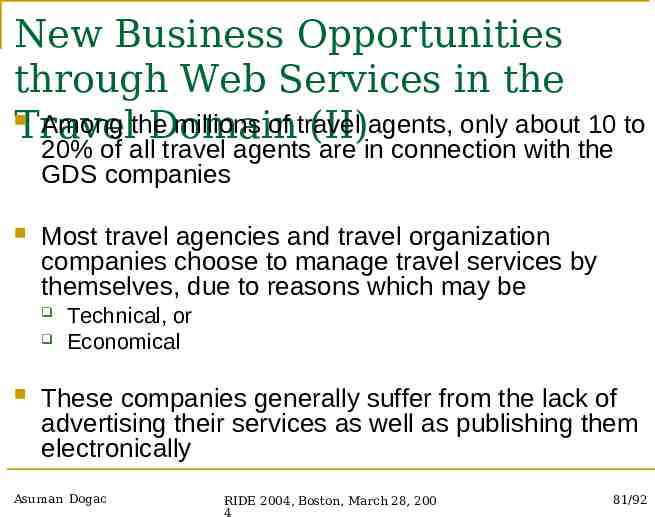
New Business Opportunities through Web Services in the Among the millions of travel agents, only about 10 to Travel Domain (II) 20% of all travel agents are in connection with the GDS companies Most travel agencies and travel organization companies choose to manage travel services by themselves, due to reasons which may be Technical, or Economical These companies generally suffer from the lack of advertising their services as well as publishing them electronically Asuman Dogac RIDE 2004, Boston, March 28, 200 4 81/92
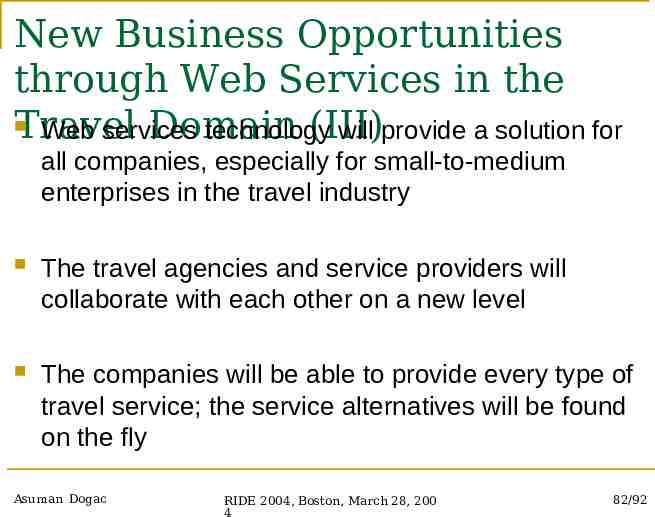
New Business Opportunities through Web Services in the Travel Domain (III) Web services technology will provide a solution for all companies, especially for small-to-medium enterprises in the travel industry The travel agencies and service providers will collaborate with each other on a new level The companies will be able to provide every type of travel service; the service alternatives will be found on the fly Asuman Dogac RIDE 2004, Boston, March 28, 200 4 82/92
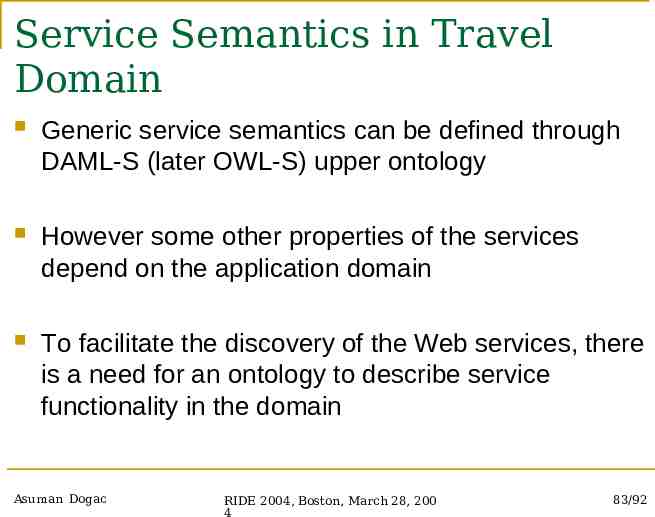
Service Semantics in Travel Domain Generic service semantics can be defined through DAML-S (later OWL-S) upper ontology However some other properties of the services depend on the application domain To facilitate the discovery of the Web services, there is a need for an ontology to describe service functionality in the domain Asuman Dogac RIDE 2004, Boston, March 28, 200 4 83/92
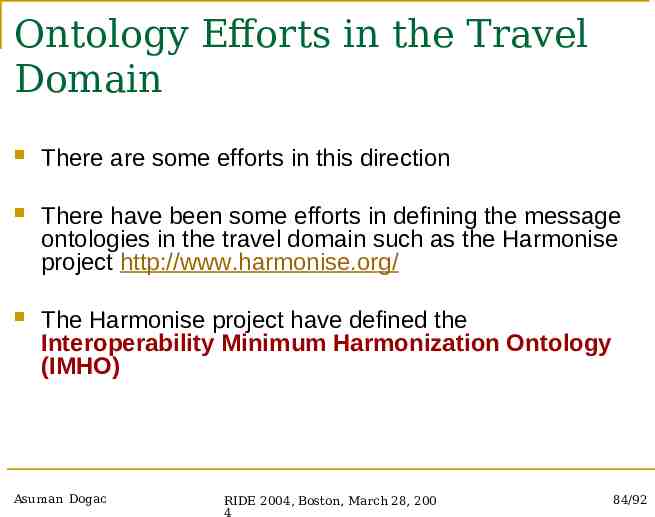
Ontology Efforts in the Travel Domain There are some efforts in this direction There have been some efforts in defining the message ontologies in the travel domain such as the Harmonise project http://www.harmonise.org/ The Harmonise project have defined the Interoperability Minimum Harmonization Ontology (IMHO) Asuman Dogac RIDE 2004, Boston, March 28, 200 4 84/92
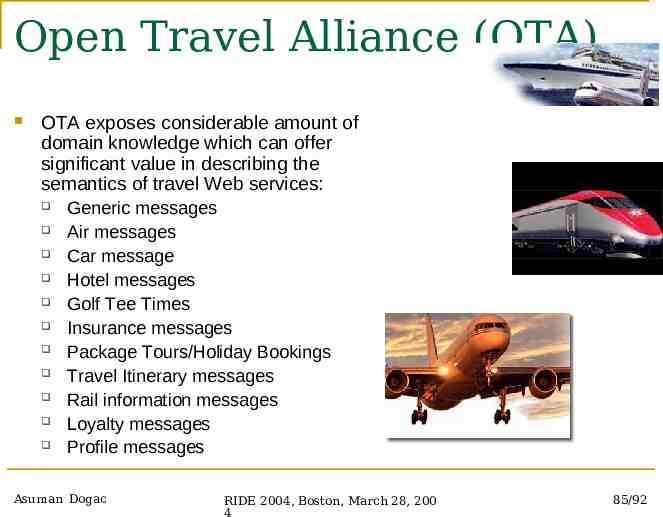
Open Travel Alliance (OTA) OTA exposes considerable amount of domain knowledge which can offer significant value in describing the semantics of travel Web services: Generic messages Air messages Car message Hotel messages Golf Tee Times Insurance messages Package Tours/Holiday Bookings Travel Itinerary messages Rail information messages Loyalty messages Profile messages Asuman Dogac RIDE 2004, Boston, March 28, 200 4 85/92
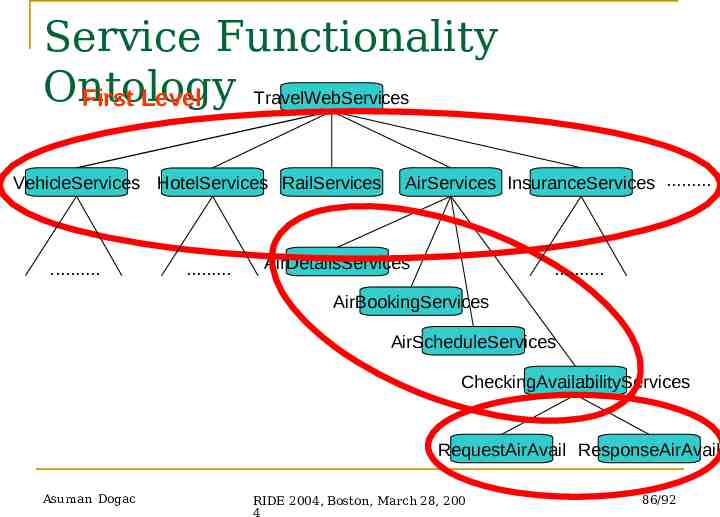
Service Functionality Ontology TravelWebServices First Level VehicleServices HotelServices RailServices . . AirServices InsuranceServices . AirDetailsServices . AirBookingServices AirScheduleServices CheckingAvailabilityServices RequestAirAvail ResponseAirAvail Asuman Dogac RIDE 2004, Boston, March 28, 200 4 86/92
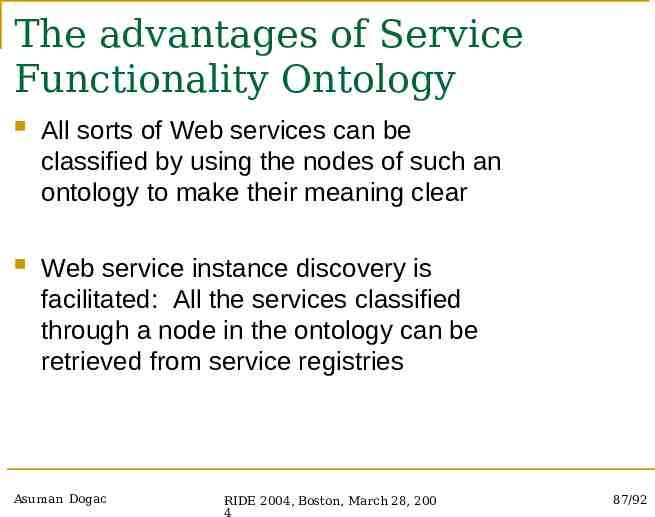
The advantages of Service Functionality Ontology All sorts of Web services can be classified by using the nodes of such an ontology to make their meaning clear Web service instance discovery is facilitated: All the services classified through a node in the ontology can be retrieved from service registries Asuman Dogac RIDE 2004, Boston, March 28, 200 4 87/92
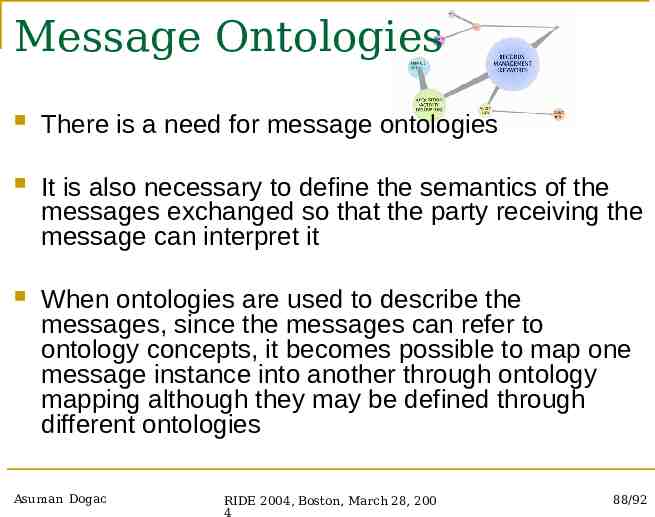
Message Ontologies There is a need for message ontologies It is also necessary to define the semantics of the messages exchanged so that the party receiving the message can interpret it When ontologies are used to describe the messages, since the messages can refer to ontology concepts, it becomes possible to map one message instance into another through ontology mapping although they may be defined through different ontologies Asuman Dogac RIDE 2004, Boston, March 28, 200 4 88/92
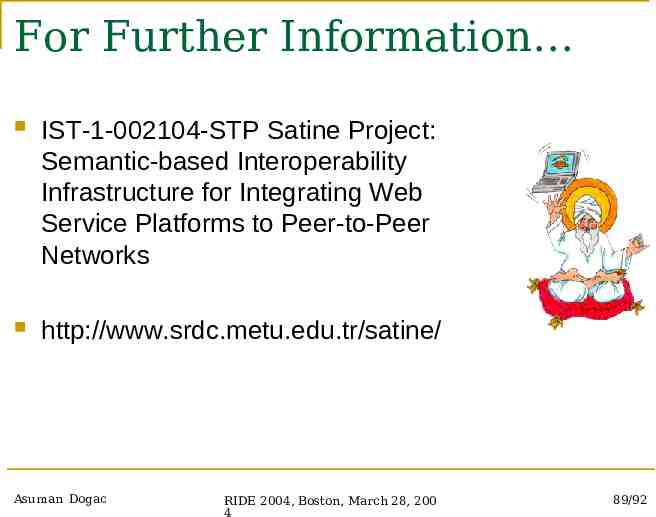
For Further Information IST-1-002104-STP Satine Project: Semantic-based Interoperability Infrastructure for Integrating Web Service Platforms to Peer-to-Peer Networks http://www.srdc.metu.edu.tr/satine/ Asuman Dogac RIDE 2004, Boston, March 28, 200 4 89/92
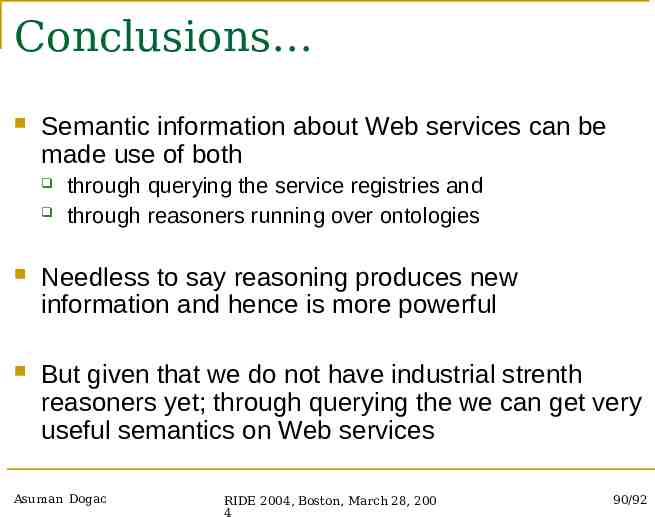
Conclusions Semantic information about Web services can be made use of both through querying the service registries and through reasoners running over ontologies Needless to say reasoning produces new information and hence is more powerful But given that we do not have industrial strenth reasoners yet; through querying the we can get very useful semantics on Web services Asuman Dogac RIDE 2004, Boston, March 28, 200 4 90/92
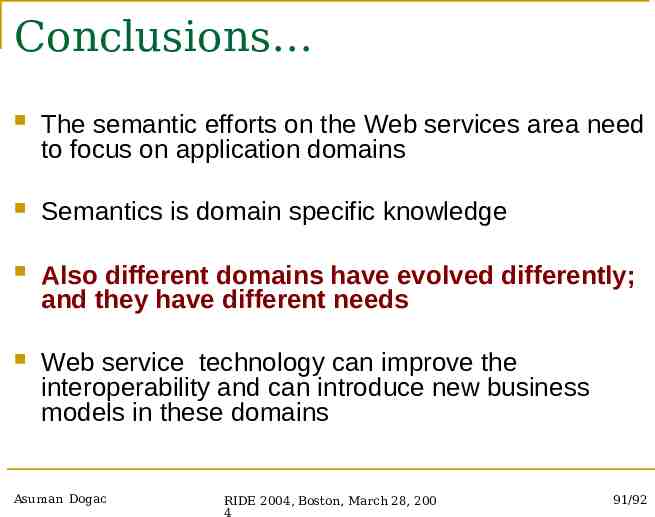
Conclusions The semantic efforts on the Web services area need to focus on application domains Semantics is domain specific knowledge Also different domains have evolved differently; and they have different needs Web service technology can improve the interoperability and can introduce new business models in these domains Asuman Dogac RIDE 2004, Boston, March 28, 200 4 91/92

Thank you for your attention! Asuman Dogac RIDE 2004, Boston, March 28, 200 4 92/92

